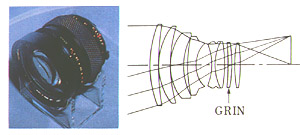|
GRIN
Lens

85mm f1.4 prototype
exhibited at the Olympus Technology Fair in 1989.
(from Photographic Industries, Dec 1989)
With their sense of
the ideal image, optical engineers are only too aware of the drawbacks
of conventional lens. One type may suffer from spherical aberration
while another shows signs of field curvature and still another has chromatic
aberration. They readily acknowledge the achievements of aspherical
lenses in correcting spherical aberration, and they agree that ED lenses
made from extraordinary dispersion glass have minimized chromatic aberration.
But they are still hard to satisfy.
Especially with the development of high-definition television, they
are working to develop a compact, light-weight lens capable of reproducing
fine details. With their research on a GRIN lens for white-light imaging,
Olympus optical engineers may have the answer. While other lenses overcome
one drawback or another, their gradient index - or GRIN , for short
- lens will solve all of the problems simultaneously.
Where a conventional lens uses a series of elements to bend light, both
the glass itself and the polished surface contribute to the refraction
of the GRIN design. The vital design factor is the varying refractive
indexes at different points in the glass.
Since no one had attempted to produce a GRIN lens for white-light imaging,
the engineers had to develop not only the materials but also a measuring
device to achieve the uneven distribution they needed.
The key lay in using the sol-gel technique of glassmaking and adding
larger amounts of metal ion near the center of the element and lower
quantities around the edges.
( from Olympus Pursuit, Vol. 13 No. 4 1994)
Olympus
Technology Fair (1989)
New imaging technologies
shown in the Fair include:
The
Olympus Cerebrum System
Named after
the portion of the brain responsible for conscious thought. The system
is a stride toward the intelligent camera that "thinks" the way we do.
The system's viewfinder can follow a moving subject, constantly adjusting
the focus and exposure. The exposure system also represents a fundamental
departure by determining brightness according to the rate of reflected
light.
Ultrasonic
waves camera motor

(from Photographic
Industries, Dec 1989)
Three types of motor:
CUM - Cylindr-type Ultrasonic Motor
LUM - Linear-type Ultrasonic Motor
PUM - Precession-type Ultrasonic Motor
Instead of depending on conventional
electric motors, Olympus has designs incorporating ultrasonic waves
to regulate film advance, rewind, exposure and shutter release. The
advantages lie in their quiet operation, compactness and speed.
Static
induction transistor (SIT) imager
The new imager has sensitivity
10 times that of conventional CCD sensors. With each working independently,
the SIT picture cell amplify the light signal, bringing greater clarity
and speed even in difficult lighting.
(from Olympus Pursuit, Vol.
9 No. 1 1990)
Olympus
CCD Philosophy
4 mega
pixels CCD is good enough for consumer use
In the Camedia E-10
press conference on 22 August 2000, the President of Olympus, Mr Masatoshi
Kishimoto gave the following remarks.
"We will stop the research on high resolution CCD."
"We have been continuously developing high quality digital camera with
high resolution CCD. But E-10's 4M pixels CCD is able to give very satisfactory
results even in enlarged prints. I think this is the end of the high
resolution CCD competition."
"5M or 6M pixels are too
much for consumer use. Operation, design and other added values are
more important from now on."
A Strange Phenomenon
An increase in the number
of CCD pixels does not always result in better image quality. Rapid
advance has been made in the number of pixels, but the progress of CCD
size falls behind. This results in the closing up of pixel pitch.
"A �inch, 2M pixels CCD
gives higher image quality than a 1/1.8inch, 3M pixels CCD." Mr Yusuke
Kojima, General Manager of Olympus DI Project Promotion Division commented.
The increase in noise and
decrease in sensitivity cause this strange phenomenon. It is also why
aperture smaller than F11 cannot be used in a 3M pixels CCD.
The only solution is to
increase the CCD size. This will increase the cost of production, since
the number of CCD produced from a silicon wafer is reduced. Thus large
CCD is only equipped in expensive professional digital camera.
5M pixels CCD
Olympus and a CCD maker
(not publicized) jointly develop the 2/3inch, 4M pixels CCD used in
E-10. Olympus is responsible for all the development cost. The pixel
size of the CCD is 3.9 micron, 0.5 micron wider than that of a 1/1.8
inch, 3M pixels CCD.
"We also planned a 2/3 inch,
5M pixels CCD. But noise increases when the pixel size is less than
3.9micron. We considered quality, price and all other things, and 4M
pixels is the turning point." Commented General Manager Kojima.
"Other makers may release
a 5M pixels model. But Olympus thinks 4M pixels is the best." Kojima
insisted.
based on a Zdnet
Japan article
(5.9.00)
|

